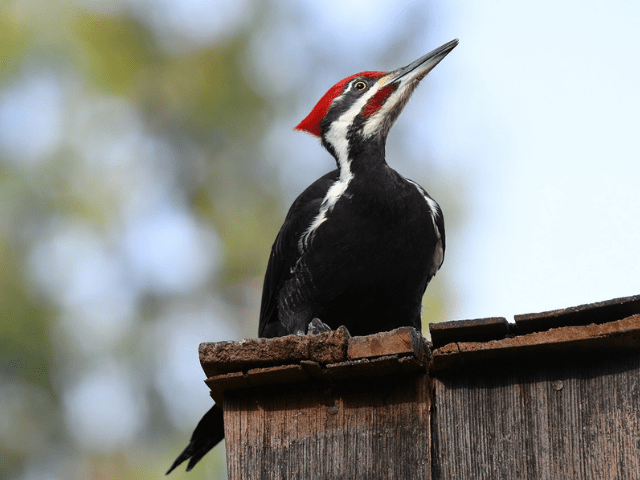In a nation inhabited by 22 species of woodpeckers, Michigan boasts of eight resident species. Three other species visit this state occasionally.
Have you seen them?
How many of the eight Michigan woodpeckers have you sighted?
In this article, we discuss all of them, plus the three migratory species spotted in MI. We compare their diet, their plumage, and their habitats. Later, we talk about ways to attract some of them to your backyard.
Michigan Woodpeckers: The 8 Common Species
1. Downy Woodpecker
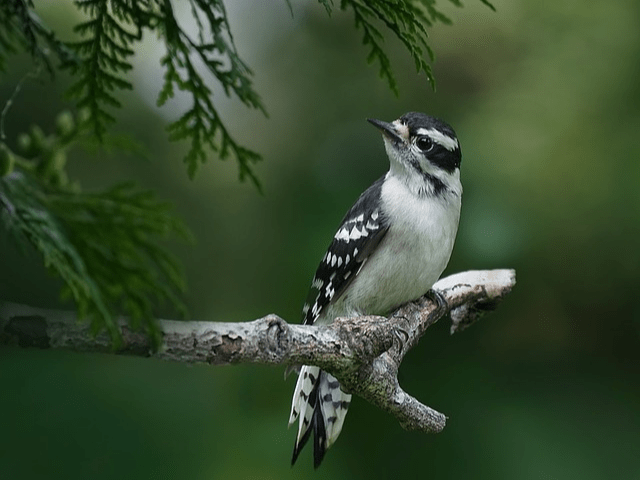
It lives in Michigan all year round, so you'll spot it a few times in parks and forests.
Its Menu
It's a regular visitor at suet feeders because of its love for sunflower seeds and peanuts. When it's not exploring bird feeders in Michigan, the downy woodpecker is drilling trees looking for insect larvae. Berries and acorns are also always on its menu.
Physical Features Of The Downy
It's small compared to other woodpeckers in Michigan as it's 5 to 7 inches long. It's also the lightest, weighing about 1 ounce, and this tiny bird has a wingspan between 9 and 12 inches.
FYI: Missouri is also home to this woodpecker species!
2. Red-Headed Woodpecker
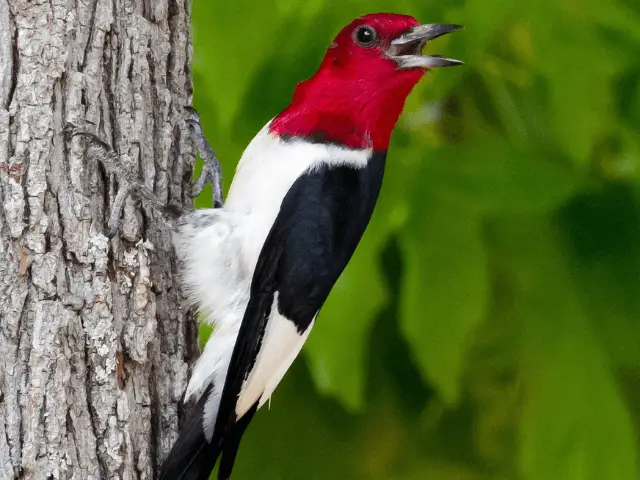
I must say, the red-headed woodpecker is the most stunning of all the woodpeckers of Michigan. It's like it's wearing red headgear over a white and black body. You should see it. Sadly, though, it denies you the opportunity to take in its beauty because it doesn't frequent bird feeders.
Favorite Food For A Red-Headed Bird
If you encounter some red-headed ones while exploring the state, they are probably looking for insects and berries. They're so skilled at hunting flies that they catch and stash live insects in tree barks.
Size Doesn't Matter To Them
Watching these tiny woodpeckers hunt is so enjoyable, given that they are just 7 to 9 inches long.
3. Pileated Woodpecker
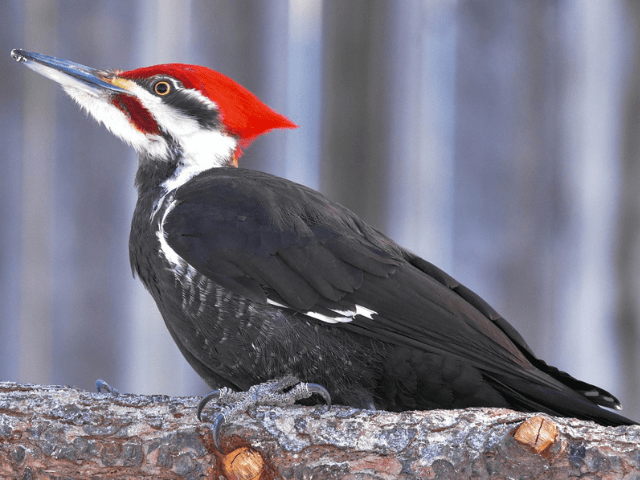
The pileated woodpecker is a resident bird that inhabits the northern section, living in deciduous forests. However, you can also find it in cemeteries and parks. Talk about spooky habitats.
Its Favorite Food
This woodpecker loves suet, but attracting it to your bird feeder is a different story altogether. Since it loves dead trees, you can create a nest for it in such a tree and finally win it over. Its favorite meal is carpenter ants, and it doesn't mind some termites or nuts.
Its Size Matters
It's the largest of the woodpeckers in Michigan as it's between 15 and 19 inches long. It's the size of a crow, so you can't miss it even without binoculars. Even before you see it, you'll hear its unique drumming sound.
Courtship And Nesting
Its courtship is almost similar to other woodpeckers though the pileated woodpecker has a spectacular courtship dance. Once the two birds have ignited the spark from February, they excavate a nest in late March.
Now you know who wears the pants in a pileated woodpecker's nest.
When their home is ready, after three to six weeks of drilling, it's time to incubate eggs.
The two birds share the task of keeping the eggs warm during the day. But, it's the male on the night shift throughout the 18 days. They welcome their bundles of joy toward the end of May and feed them in turns until the nestlings are ready to fly out about a month later.
4. Northern Flicker
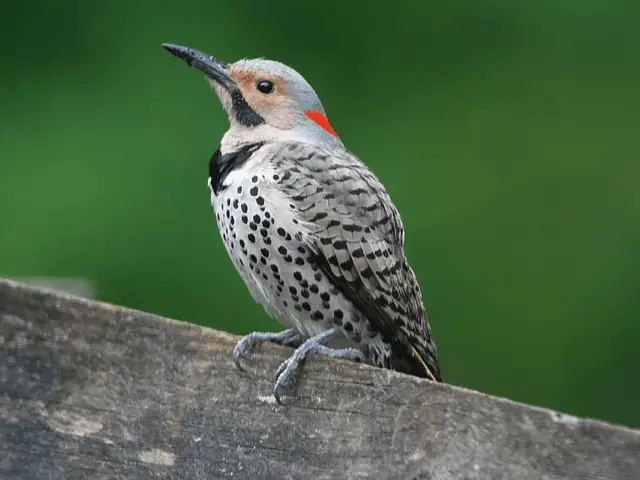
It's also a big and heavy woodpecker with a wingspan of 16 to 20 inches. However, it's not as big as the pileated woodpecker. Is it just me, or do the scallops on its white belly resemble black hearts?
Hence, I'd say it's a colorful woodpecker too. When it calls, you might think it's laughing because of its whinnying sound.
How Does It Hunt For Food?
You can spot it anywhere in MI, and unlike other woodpeckers, this one loves rummaging through the foliage on the ground for ants and grasshoppers. It's a clever hunter that drums a tree and listens.
Once it has drilled enough space, it plunges its long, retracted tongue into the hole, and the insect sticks to its saliva.
Wasps are a delicacy too, and when it's not chasing grasshoppers, the northern flicker eats berries and fruits. But that's mostly in winter when a bird has to eat what a bird has to eat.
Nesting In The Wild
When it's breeding season, March to June, this bird houses its eggs in a nest excavated between 10 and 30 feet from the ground. It excavates dead trees, branches, and telephone poles. If you've spotted a northern flicker in your backyard, you can mount a nest box for it.
5. Black-Backed Woodpecker
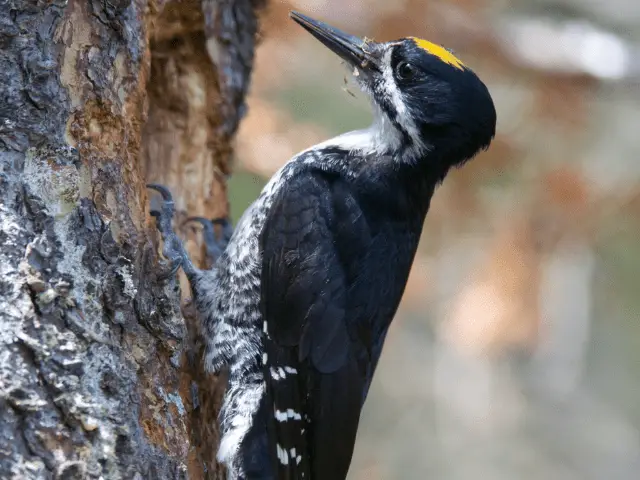
You can spot the black-backed woodpecker in the northern sections of the state all year round. It has two colors - black and white, and the males have a yellow stripe on the crown.
What It Eats
Its main meal is the beetle larvae, more specifically, the wood-boring beetle. Hence, boring trees is its favorite activity. Black-backed woodpeckers don't bore just any tree; no, they love burnt forest trees.
Nesting Ideas
They excavate nests from May to June, and they prefer dead wood stumps. They are such luxury-seekers that when it's time to nest, they drill a new hole. Both males and females excavate a nest.
Nonetheless, just like the pileated woodpecker, it's the male that excavates the nest more. The eggs incubate for about 14 days, and the nestlings fledge in 25 days.
6. Red-Bellied Woodpecker
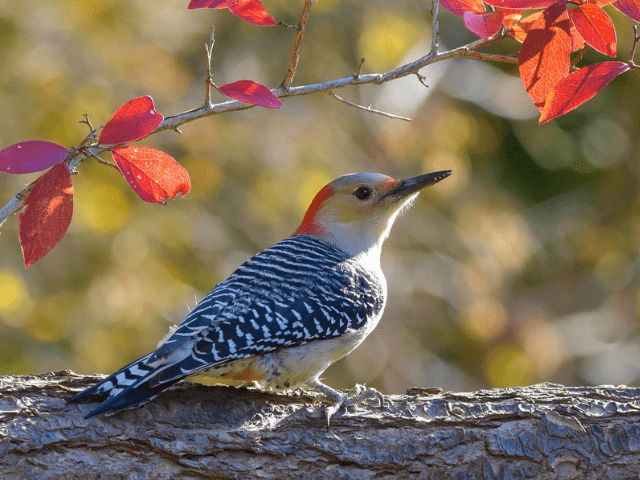
It's another resident bird, and you can attract it to your bird feeder as it loves suet.
Strangely, their bellies are not a bright red color like the crowns of the yellow-bellied sapsuckers.
Instead, they have a pale red belly, but they're still the red-bellied woodpeckers.
When they visit your backyard, look at their bellies keenly to differentiate the two woodpeckers.
Another distinguishing feature is a red nape.
How Big Is It?
The red-bellied woodpecker is slightly bigger than the black-backed woodpecker, at 9.4 inches long, though the two weigh almost the same. Its wingspan ranges between 13 and 16 inches, while the black-backed woodpecker's wingspan is 15 to 16.5 inches long.
Therefore, you can only tell them apart when you look at other characteristics, such as the color of their feathers.
Food Options
This bird inhabits the northern section of MI. It eats nuts, seeds, and fruits. You'll find it foraging in trunks and live branches of dead trees.
7. Hairy Woodpecker
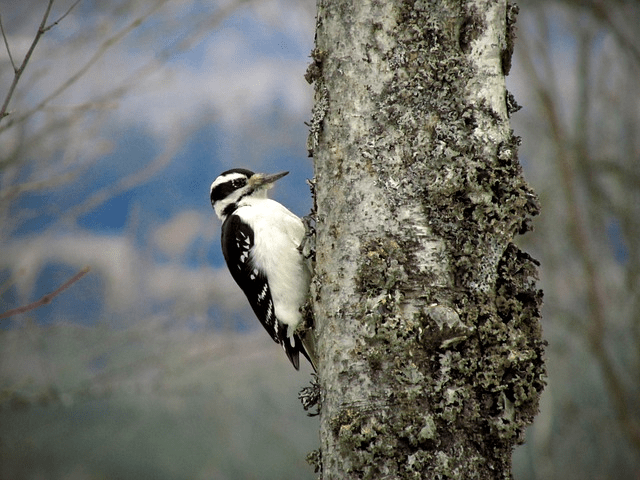
This one is almost the size of the yellow-bellied sapsucker or the red-headed woodpecker. It's about 7 to 10 inches long, and the wingspan averages 13 to 16 inches.
Yes, It's Different From A Downy.
Apart from its size similarities with the two woodpeckers I have mentioned, you may also confuse the hairy woodpecker with the downy woodpecker. They both have a white belly, black-spotted wings, and a red patch on the crown.
Their similarities go beyond the physical as they are both resident birds that love snacking at bird feeders.
Here's a cheat sheet for when you see them together:
8. Yellow-Bellied Sapsucker
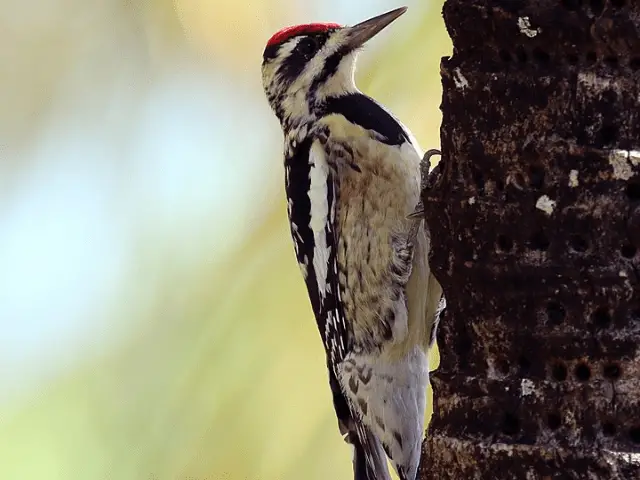
The yellow-bellied sapsucker inhabits the southern section of Michigan, and it's a migratory bird.
Its Menu
This woodpecker prefers to look for insects and sap on tree branches rather than getting regular food at your bird feeder. It visits your suet feeder occasionally.
Physical Features Of A Sapsucker
The male bird has a black back and black wings. Its belly is white, and its chest is black and yellow. Further, it has a red and black throat. The female woodpecker has a white throat, while young sapsuckers have brown plumage.
They are between 5 and 9 inches long, with a wingspan of not more than 18 inches.
What Do They Eat?
Besides sapping poplars, pines, and red maples, they also eat beetles and ants. When food is scarce, they don't mind eating nuts and fruits. Their nestlings eat a meat roll consisting of insects rolled in tree sap.
There's always a generous supply of tree sap to these woodpeckers. After drilling a row of holes, they come back later to enjoy tree sap. These birds drill up to 7 holes horizontally, forming a vertical sequence on a tree.
Nonetheless, yellow-bellied woodpeckers don't drum as much as other species.
Of all the eight types of woodpeckers in Michigan, the downy and hairy woodpeckers are the ones you're likely to see often.
Let's turn to other types seen in this state:
3 Other Species Spotted in Michigan
1. American Three-Toed Woodpecker
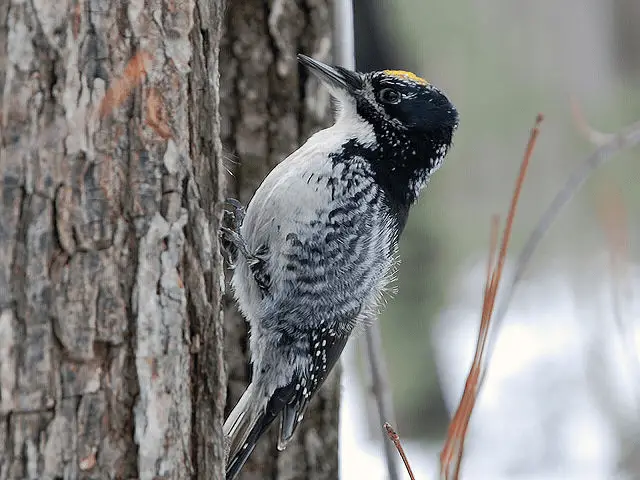
This woodpecker gets its name from the three toes on its foot. Both sexes have barred backs and flanks.
However, adult males have a yellow patch on the forehead, and it's the best way to distinguish them from other woodpeckers with black and white plumage.
2. Lewis's Woodpecker
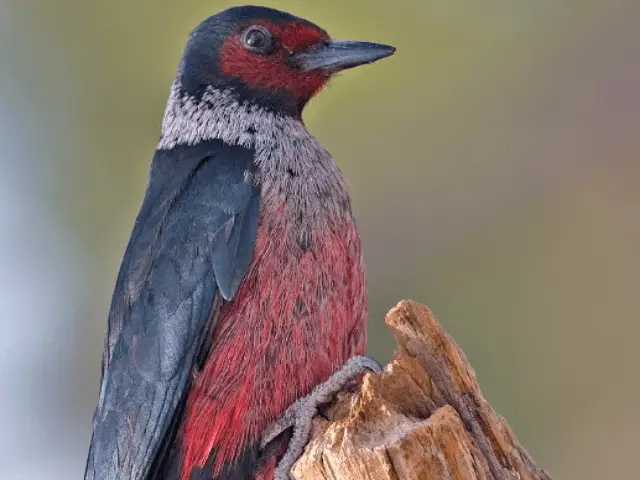
It's another colorful woodpecker that you'll most likely identify because of its pink belly. It can drum trees like other woodpeckers, but it spends more time looking for insects on trees.
It's such an exciting sight for a birder.
3. Golden-Fronted Woodpecker
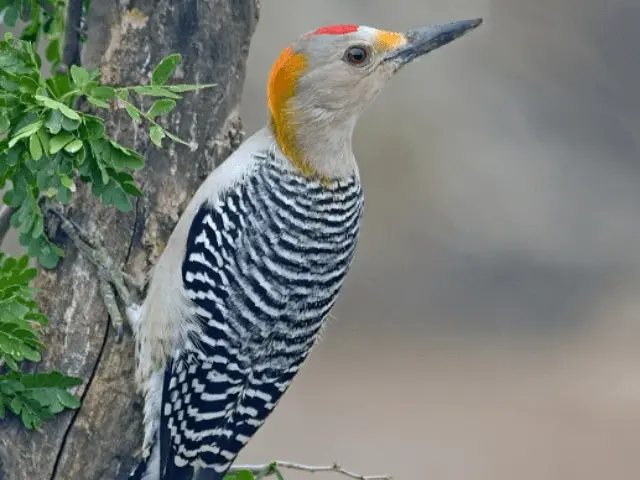
It's a rare sighting in Michigan, and if you ever encounter it, you might assume it's a red-bellied woodpecker. Its three main meals are nuts, fruits, and insects.
FYI: Know more about this species by reading the woodpeckers of Florida article.
Where To Spot Woodpeckers
Now that you already know the woodpeckers of Michigan, let's look at places to see them in this state:
Woodpeckers in this state love many ecosystems, such as forests with pine trees and swampy woodlands with dead trees. They are common in Old Mission Lighthouse Park because it has a dense forest with fallen trees that harbor fungus.
There's also an expansive wooded area around the park. Other habitats to explore in MI are the wooded ridges of Lincoln Brick Park plus the pine trees of Sleepy Hollow State Park. If you can't travel to these parks often, you can lure birds to your bird feeder.
FYI: Woodpecker species also thrive in other places! Woodpeckers in North Carolina is a good article about them being seen in the state of NC!
How To attract Woodpeckers To Your Backyard
It's one thing to see these delightful birds in the bush, and it's another thing to watch them for hours from your deck. It may take time as they are not easy to attract. However, when they come, you'll enjoy the birding experience.
Here's what you can do:
- Mount nest boxes.
- Leave dead trees for woodpeckers to drum.
- Plant fruits like blueberries and apples.
- Let ants live in colonies in your backyard.
Did you enjoy watching that lovely woodpecker drumming before it flew away? Now let's get on with answering some questions about them:
Popular Questions About MI Woodpeckers
What Kind Of Woodpeckers Live In Michigan?
The eight to see in this state are yellow-bellied sapsucker, northern flicker, red-headed, downy, hairy, red-bellied, black-backed, and pileated woodpeckers.
Do Woodpeckers Migrate To Michigan?
Most of the woodpeckers in Michigan are residents, except the yellow-bellied sapsucker. The northern flicker may also migrate during winter while other birds sighted in Michigan, such as Lewis’s woodpecker, migrate over a short distance.
Is It Illegal To Shoot A Woodpecker In Michigan?
Yes, it is. the Migratory Bird Treaty Act (MBTA) protects them from harm, sale, or exportation.
In Conclusion
If you have seen one woodpecker, you haven't seen them all. You can wait for these species at your suet feeder, but you may never attract all of them.
The pileated woodpecker might be the last to show up in your backyard, and that's if there are carpenter ants or termites. For now, gather pictures of woodpeckers in Michigan and plan when to see all eight resident species.

